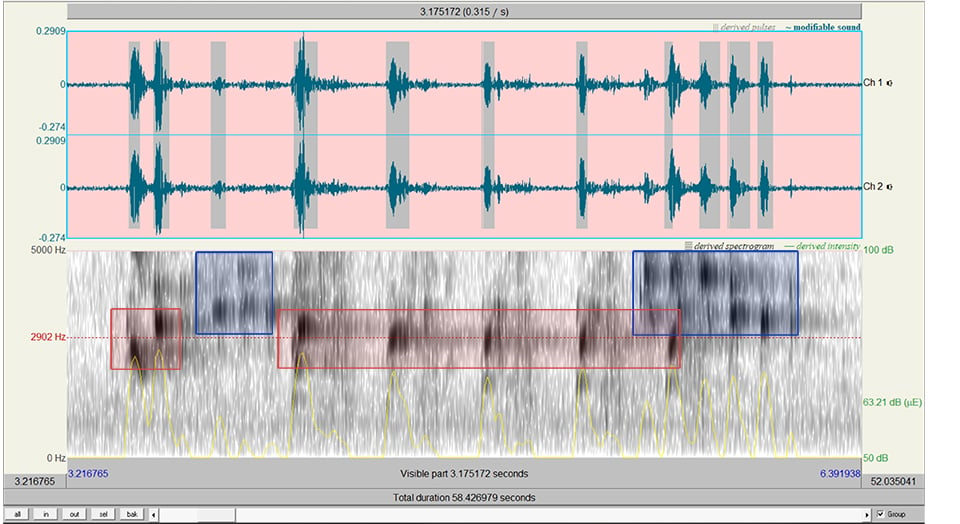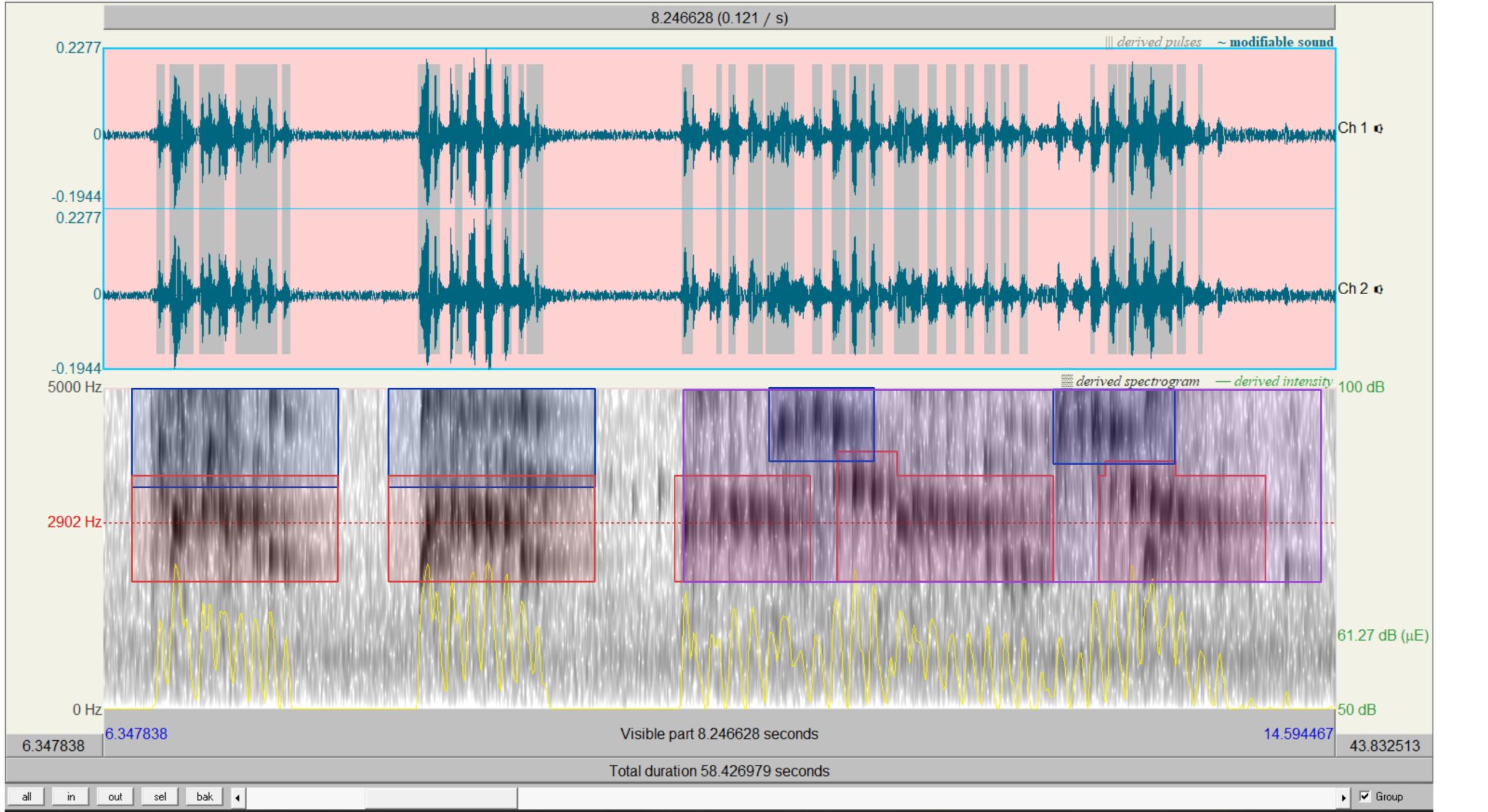HD, HM, Mr. North, and DNF vocalize by using an organ unique to birds: the syrinx, a small two-sided structure that allows birds to make complex sounds. Both sides of a bird’s syrinx are equally capable of producing sound and can be used alone or in concert to sing two different notes simultaneously and complete broad sweeps in pitch quickly.
 Dorsal view of Sparrowhawk syrinx. a1-a4: Cartilages of tracheosyringeal rings, a2-a4: Black arrows: Sternotracheal muscle, White arrows: Tracheolateral muscle, MTM: Membrana tympaniformis medialis, MTL: Membrana tympaniformis lateralis, P: Pessulus, (*): Ligamentum interbronchiale, RB: Right bronchiole, LB: Left bronchiole. The syrinx can produce complex sounds, but does not appear large or complex.
Dorsal view of Sparrowhawk syrinx. a1-a4: Cartilages of tracheosyringeal rings, a2-a4: Black arrows: Sternotracheal muscle, White arrows: Tracheolateral muscle, MTM: Membrana tympaniformis medialis, MTL: Membrana tympaniformis lateralis, P: Pessulus, (*): Ligamentum interbronchiale, RB: Right bronchiole, LB: Left bronchiole. The syrinx can produce complex sounds, but does not appear large or complex.
While singing ability and song role varies widely from species to species, a bird generally produces sound by modifying the air that flows through its syrinx. Depending on the species, this might involve:
- Vibrating the syrinx or pessulus, a delicate bar of cartilage found at the junction of the bronchial tubes and trachea.
- Forcing air through fine tissues that stretch along the inner and outer walls of the syrinx.
- Using syringeal muscles to change the tension and shape of the membranes and bronchial openings.
- Choosing the left or right side of the syrinx to produce a lower or higher-pitched sound.
Birds and humans produce sound and speech in very different ways. Birds can use 100% of the air passing through their syrinx to create sound, whereas we use about two percent of the air passing through our larynx to vibrate two ligaments that create sound. We manipulate that sound with our mouths to create phonemes, the building blocks of spoken language. Basic speech is a two-part process for us: vocal cords + mouth = speech. All spoken human languages together consist of about 163 sounds according to the International Phonetic Alphabet. Birds make a lot more sounds than we do – I sometimes wonder what an avian IPA might look like! – and they do almost all of it with one organ: the syrinx.
Different Birds, Different Capabilities
Don Strap’s book Birdsong tells us that Turkey Vultures have no syrinx (which explains the sounds we hear coming from the Missouri Turkey Vulture Loft), geese have one pair of syringeal muscles, most non-passerine birds have two pairs, and songbirds have fine to seven pairs. More muscles = more control, so it isn’t surprising that songbirds have more than geese. I wasn’t able to learn much about Bald Eagles, but anatomical studies of Long-legged Buzzards (Buteo rufinus) and Sparrowhawks (Accipiter nisus) indicate that raptors have relatively simple syrinxes.
Having said that, I wonder about Bald and Golden Eagles. The two species aren’t very closely related, but they make more complex sounds than many other raptors. Birds of the World identifies four sounds for nestling Golden Eagles and eleven sounds for adults, including rattle-chirps, wonks, barks, wips, and wak-wak-waks. They identify two sounds for nestling bald eagles and four sounds for adults, although – in accordance with our observations – the authors note that other rarely heard vocalizations likely exist but are not well described or studied.
The Bald Eagle’s keek or chatter call has been described as ‘weak-sounding’, ‘shrill’, ‘cackling’, and ‘not very impressive’. But a deeper dive into eagle conversation reveals a surprisingly fascinating and complex sound: something much more complicated than the Red-tailed Hawk scream that filmmakers usually dub in. Let’s take a look!
HD and HM’s morning conversation
HD and HM treated us to a lovely conversation on the morning of December 4. It started with HM’s alarm call, which looked and sounded like this…
 HD and HM have just woken up. HM gives an alarm or peal call, perhaps in response to something we can’t see. Individual notes are long, slightly rising, and often have a short higher-pitched voice break at the end, as we see here.
HD and HM have just woken up. HM gives an alarm or peal call, perhaps in response to something we can’t see. Individual notes are long, slightly rising, and often have a short higher-pitched voice break at the end, as we see here.
HD and HM: Chatter and Chirps
 HM and HD briefly chatter. HM gives five short chirps. HD chimes in with another brief chatter call between her fourth and fifth chirp. Her calls are outlined in coral and his are outlined in blue. Note that his voice is pitched is higher than hers, although there is some overlap at the top and bottom of their ranges.
HM and HD briefly chatter. HM gives five short chirps. HD chimes in with another brief chatter call between her fourth and fifth chirp. Her calls are outlined in coral and his are outlined in blue. Note that his voice is pitched is higher than hers, although there is some overlap at the top and bottom of their ranges.
HD and HM: Harmonizing and Call and Response
 HD and HM begin duetting. They are harmonizing during the first two sections. In the third section, they appear to be calling and responding to one another. Again, his pitch is higher than hers, although there is some overlap. In the third section, intensity, defined by the yellow line, is highest when the two are vocalizing at the same time.
HD and HM begin duetting. They are harmonizing during the first two sections. In the third section, they appear to be calling and responding to one another. Again, his pitch is higher than hers, although there is some overlap. In the third section, intensity, defined by the yellow line, is highest when the two are vocalizing at the same time.
HD and HM: Final Duet
 HD and HM started their conversation with HM’s peal call, followed by chattering and chirps and a duet section that included harmony and call-and-response. But I thought the last part was fascinating! It opens with two sharp chirps from HD, followed by two lower chirps from HM. The two call and respond until the middle section, marked in purple. He makes three high chirps and she makes three low chirps. The chirps are almost mirror images of one another, but pitched down. This sequence ends with two sharp chirps from HD and is fairly symmetrical throughout.
HD and HM started their conversation with HM’s peal call, followed by chattering and chirps and a duet section that included harmony and call-and-response. But I thought the last part was fascinating! It opens with two sharp chirps from HD, followed by two lower chirps from HM. The two call and respond until the middle section, marked in purple. He makes three high chirps and she makes three low chirps. The chirps are almost mirror images of one another, but pitched down. This sequence ends with two sharp chirps from HD and is fairly symmetrical throughout.
Research by the Max Planck Institute for Ornithology found that the brains of weaver birds synchronize when they sing duets: i.e., vocal control areas fire in time when they sing together. While we don’t know whether eagles do the same thing, I was fascinated by HD and HM’s song. They harmonized, called and responded, and echoed one another’s vocals. Eagles aren’t songbirds and HM and HD’s song wasn’t as complex as that of songbirds, but it was a song and mutual vocalizations are an important part of eagle bonding. The next time that someone calls an eagle’s vocalizations ‘weak’, ‘shrill’, or ‘silly’, let them know that eagle songs are more complicated than we give them credit for.
Things that helped me learn about this
Did you know?
 The Raptor Resource Project
The Raptor Resource Project The Raptor Resource Project
The Raptor Resource Project